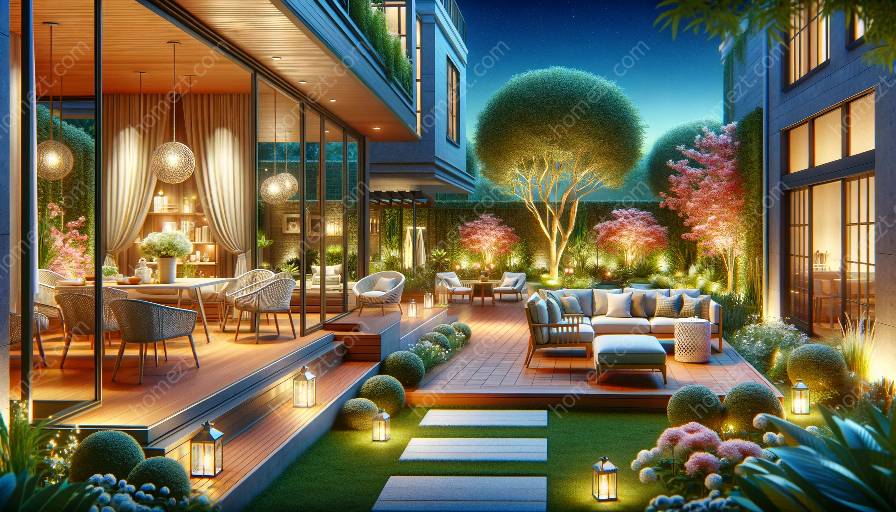Color theory plays a crucial role in enhancing the aesthetic appeal of garden design and creating harmonious outdoor living spaces. This topic cluster explores the principles of color theory, its application in garden design, and how it complements both outdoor living spaces and interior design. By understanding the psychology of colors, the use of color schemes, and the impact of different hues, garden enthusiasts and interior designers can create captivating environments that evoke various emotions and impressions.
The Fundamentals of Color Theory
Color theory is the study of colors and how they interact with one another. Understanding the fundamentals of color theory is essential in garden design, as it can significantly impact the visual appeal and atmosphere of outdoor living spaces. The three primary components of color theory are:
- Hue: This refers to the basic color families, such as red, blue, yellow, and green. Each hue has its own set of psychological associations and can evoke different emotions and moods.
- Saturation: Saturation, also known as chroma or intensity, refers to the purity and vividness of a color. Understanding saturation is crucial in creating dynamic and impactful color schemes in garden design.
- Value: Value represents the lightness or darkness of a color. By manipulating the value of different hues, designers can create depth and contrast within garden landscapes.
Psychology of Colors in Garden Design
Colors have the power to influence human emotions and perceptions, making them a fundamental aspect of garden design and interior styling. Each color has its own psychological properties and can evoke specific feelings and associations:
- Red: Associated with passion, energy, and excitement, red is a bold color choice for garden design. It can create focal points and add vibrancy to outdoor spaces.
- Blue: Symbolizing serenity and tranquility, blue is ideal for creating calming garden environments. It can evoke a sense of relaxation and peace.
- Yellow: Representing happiness and warmth, yellow adds a cheerful and uplifting touch to garden design. It can brighten up outdoor living spaces and create a welcoming atmosphere.
- Green: As the color of nature, green is essential in garden design. It symbolizes renewal, harmony, and balance, making it perfect for creating cohesive and refreshing outdoor landscapes.
- Purple: Often associated with luxury and creativity, purple can add a touch of elegance and sophistication to garden design. It is a versatile color that can bring a sense of mystery and intrigue to outdoor settings.
- Orange: A vibrant and energetic color, orange can add warmth and vitality to garden design. It is an excellent choice for creating lively and dynamic outdoor spaces.
- Color Schemes: Understanding color schemes, such as complementary, monochromatic, and analogous, can help designers create cohesive and balanced color palettes for garden design. These color schemes can be used to evoke specific moods and enhance the overall ambiance of outdoor living spaces.
- Seasonal Variation: Consideration of seasonal changes and the effects of different lighting conditions is essential in creating dynamic and evolving garden designs. Colors can adapt to different seasons, adding visual interest and creating ever-changing outdoor environments.
- Emphasis and Focal Points: Strategic use of color can draw attention to specific elements within garden landscapes. By creating focal points through color, designers can guide the visual flow and create captivating outdoor experiences.
Application of Color Theory in Garden Design
By applying the principles of color theory, designers can create visually stunning and harmonious garden landscapes that complement outdoor living spaces and interior design. Some key considerations for the application of color theory in garden design include:
Interplay with Interior Design and Styling
The principles of color theory and their application in garden design have a direct impact on interior design and styling. Seamless integration of color palettes and themes enhances the connection between outdoor and indoor living spaces, creating a harmonious and coherent environment.
Bringing the Outdoors In
Utilizing consistent color themes and elements in both garden design and interior styling can blur the boundaries between outdoor and indoor living spaces. This approach fosters a sense of continuity and harmony, allowing for a seamless transition between the natural beauty of the garden and the comfort of interior living spaces.
Creating Visual Flow
By considering color theory in both garden and interior design, designers can establish a visual dialogue that enhances the overall flow and cohesion of living environments. Consistent color palettes and complementary hues create a harmonious connection, leading to a more balanced and integrated design.
Enhanced Atmosphere and Ambiance
Colors play a pivotal role in shaping the atmosphere and ambiance of both outdoor and indoor spaces. By harmonizing color schemes and themes, designers can create environments that exude a sense of unity and tranquility, promoting well-being and relaxation.
Conclusion
Color theory is a versatile tool that significantly impacts garden design, outdoor living spaces, and interior styling. By leveraging the principles of color theory, designers can create captivating environments teeming with emotional resonance and visual harmony. This comprehensive understanding of color theory and its application breathes life into garden landscapes, fosters a seamless connection between outdoor and indoor living spaces, and transforms living environments into a harmonious sanctuary of beauty and tranquility.


























